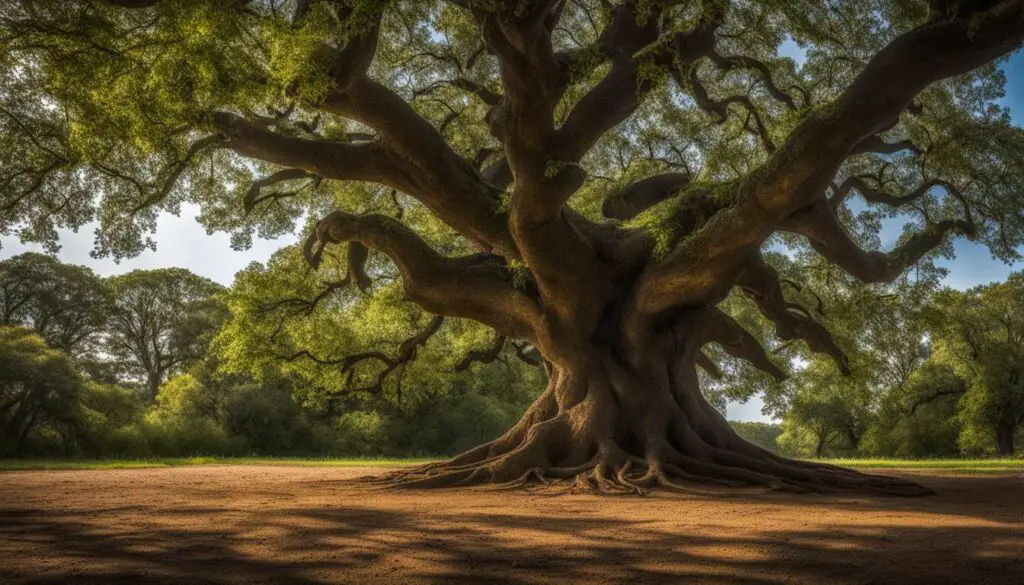Oaks, belonging to the genus Quercus, are a remarkable group of trees that have evolved and diversified over millions of years. With their immense ecological and economic significance, oak trees play a crucial role in the functioning of forests and support diverse organisms. Today, there is a rich variety of oak tree species found across the globe, each with its own unique characteristics and adaptations.
When it comes to the number of oak tree species, the count stands at approximately 435 species worldwide. These species are distributed across five continents, showcasing the incredible diversity of oak trees.
Understanding the classification and taxonomy of oak trees can help us appreciate their different types and varieties. From the red oak group to the white oak group, each lineage exhibits distinct characteristics that contribute to the overall biodiversity of oaks.
Key Takeaways:
- Oaks are keystone species in forests and support diverse organisms.
- There are approximately 435 species of oak trees found worldwide.
- Oak trees are classified into different groups, such as the red oak and white oak groups.
- The diversity of oak trees contributes to their ecological and economic significance.
- Conservation efforts are important to protect and preserve oak tree biodiversity.
The Evolutionary History of Oaks
Oaks, belonging to the genus Quercus, have a fascinating evolutionary history that spans over millions of years. These iconic trees originated around 56 million years ago and were initially distributed across North America, Europe, and Asia. As they spread and adapted to various environments, oaks underwent significant diversification, resulting in the wide array of oak species we see today.
During their evolutionary journey, oaks experienced a remarkable dispersal and diversification process. Over time, they separated into two major branches, each taking a distinct path. One branch remained prevalent in Europe, Asia, and North Africa, while the other primarily thrived in the Americas.
As the Earth’s climate cooled, oaks faced new challenges and had to adapt to changing conditions. This led to a significant southward migration, resulting in a distinct division between oak species on the two continents.
In their new geographic locations, oaks continued to evolve and diversify, giving rise to eight major lineages that can still be observed in today’s forests. These lineages display unique characteristics and adaptations, contributing to the remarkable biodiversity of oak trees.
Understanding the evolutionary history of oaks provides valuable insights into their adaptation strategies, genetic diversity, and ecological roles. By examining the past, scientists can gain a deeper appreciation for the complexity and resilience of these majestic trees.
The Differences Between Red Oaks and White Oaks
In the Americas, oaks are dominated by two major evolutionary lineages: the red oak group and the white oak group. These groups share some common characteristics but also exhibit distinct differences.
The red oak group includes various species such as the Northern red oak (Quercus rubra), Scarlet oak (Quercus coccinea), and Pin oak (Quercus palustris). Red oaks are known for their bristle-tipped leaves, which have small sharp projections at the edges. These leaves often feature pointed lobes and a characteristic deep green color.
The white oak group, on the other hand, encompasses species like the White oak (Quercus alba), Swamp white oak (Quercus bicolor), and Bur oak (Quercus macrocarpa). White oaks have leaves without bristles, possessing lobes that are rounded at the tips. Their leaves typically display a lighter shade of green compared to red oaks.
An interesting difference between these two groups lies in their acorn development. Red oaks require a full year for acorns to ripen after pollination, while white oaks generally have acorns that ripen in the same year as pollination. This variation in acorn maturation timings can affect the foraging strategies of animals that rely on oak acorns as a food source.
Another distinctive feature is the presence of water-conducting cells, called vessels, in white oaks. These vessels can be effectively plugged to resist fungal diseases, enhancing the tree’s defense mechanisms. In contrast, red oaks have less effective mechanisms for preventing fungal infections, which can make them more vulnerable to certain diseases.
| Red oaks | White oaks |
|---|---|
| Bristle-tipped leaves | Leaves without bristles |
| Acorns ripen after one year | Acorns generally ripen in the same year |
| Less effective defense mechanisms against fungal diseases | Water-conducting vessels that can be plugged to resist fungal diseases |

Understanding the distinctions between red oaks and white oaks can aid in their identification and provide insights into their ecological roles. These differences contribute to the overall diversity of oak trees and highlight the remarkable adaptations and strategies developed by different species within the genus Quercus.
The Remarkable Diversity of Oak Hybrids
Oaks are known for their remarkable diversity, with countless variations within species and frequent hybridization between different oak species. This complex process of hybridization contributes to the rich tapestry of oak tree genetic variation.
Traditional biomolecular techniques have long been used to study oak genetics, but they have limitations when it comes to unraveling the intricate history of speciation and hybridization in these trees. However, recent advancements in genome sequencing and analysis have revolutionized our understanding of oak evolution.
Genome sequencing has allowed scientists to delve deep into the oak tree’s genetic code, piecing together a mosaic-like genome shaped by countless instances of speciation and hybridization. By examining the entire genome, researchers can identify the genetic footprints left behind by past hybridization events and better understand how new oak tree hybrids arise.
“The study of oak hybrids has revealed the astounding complexity of their genetic makeup, challenging traditional notions of oak taxonomy and classification,” explains Dr. Elizabeth Ramirez, a leading expert in plant genetics. “Through the analysis of whole genomes, we can now trace the intricate genetic threads that unite and differentiate oak species.”
By unraveling the secrets of oak tree genetic variation, scientists gain valuable insights into the evolutionary processes that have shaped these majestic trees. Understanding the patterns and mechanisms of hybridization in oak trees is essential for preserving their biodiversity and adapting conservation strategies accordingly.
| Key Insights |
|---|
| Oaks exhibit high levels of genetic variation within species. |
| Hybridization between oak species is a common occurrence. |
| Recent advances in genome sequencing and analysis have allowed scientists to reconstruct the complex history of oak evolution. |
The Global Distribution and Importance of Oaks
Oak trees are widely distributed around the world, with a significant concentration found in the Americas. Approximately 60% of all oak species can be found in North America, making oaks the most important group of trees in North American forests. However, these magnificent trees also have a wide geographical distribution across other continents, including Europe and Asia.
Oaks play a vital role in maintaining forest biodiversity and supporting complex food webs. They provide shelter, habitat, and an abundant food source for numerous organisms, including birds, insects, mammals, and fungi. This contributes to the overall health and stability of ecosystems.
Furthermore, oak trees have immense ecological significance. They contribute to air purification by absorbing pollutants and releasing oxygen, and they play a crucial role in carbon sequestration, helping to mitigate the effects of climate change. The large size and long lifespan of oak trees make them important carbon sinks, storing vast amounts of carbon dioxide in their biomass.
Aside from their ecological importance, oaks hold cultural and economic value. They have been integral to human societies for centuries, symbolizing strength, endurance, and wisdom. Oak wood is highly sought after for its durability and is used in various industries, including construction, furniture, and winemaking. Oak leaves are used as decorative symbols and often featured in military insignia and awards.
Overall, oak trees have a significant impact on both natural and human systems. Their global distribution and ecological significance highlight their importance in maintaining biodiversity and supporting the well-being of both ecosystems and people.

| Continent | Number of Oak Species |
|---|---|
| North America | Approximately 60% of all oak species |
| Europe | Approximately 144 oak species |
| Asia | Approximately 51 oak species |
| Africa | Approximately 26 oak species |
| South America | Approximately 57 oak species |
| Australia | Approximately 8 oak species |
| Other Continents | Approximately 139 oak species |
The Ecological Interactions of Oaks
Oaks play a crucial role in supporting diverse ecological interactions. They support a wide range of organisms, including fungi, insects, birds, and mammals. Oaks provide food resources, such as acorns and leaves, that sustain various species. Many insects, including caterpillars, depend on oaks as their primary food source. Birds rely on insects, especially caterpillars, to feed their young. Oaks also engage in symbiotic relationships with mycorrhizal fungi, which help in nutrient absorption.
This intricate network of ecological interactions forms the oak tree foodweb, where different species rely on each other for survival and stability. The oak tree acts as a hub, providing resources and services that support the health and functioning of the entire ecosystem.
Oak Trees and Human Culture
Oaks have held great cultural significance for centuries, being revered by ancient civilizations such as the Druids, Greeks, Romans, Celts, Slavs, and Vikings. These civilizations considered oak trees to be sacred and associated them with strength and endurance.
One of the reasons oak trees have had such a profound impact on human culture is due to the versatility and durability of oak wood. Oak wood has been widely used for shipbuilding, furniture making, and the production of barrels for aging whisky and wine. Its strength and resistance to decay make it a highly prized material.
“The mighty oak, a symbol of strength and endurance,” as said by the ancient civilizations.”
In addition to its practical uses, oak trees also have symbolic value. Oak leaves, with their distinct lobed shape, are often used as decorative symbols for military ranks, awards, and emblems. The oak tree itself is often associated with wisdom, longevity, and resilience.
Furthermore, oak trees have been immortalized in various legends and myths throughout history. These stories highlight the cultural and historical importance of oaks, portraying them as majestic and powerful beings deeply intertwined with the human experience.

From their sacred status in ancient rituals to their prominent role in folklore and literature, oak trees continue to captivate our imagination and hold a significant place in human culture.
The Fascinating Phenomenon of Marcescent Leaves
Marcescent leaves, which are dead leaves that persist on oak trees, have puzzled scientists. The phenomenon is believed to serve as a defense mechanism against bud-eating animals and a strategy for water retention during drought. The persistence of marcescent leaves may also promote nutrient cycling and create a favorable environment for detritovores and fungi in the leaf litter, benefiting the oak tree and the forest ecosystem.

| Marcescent Leaves | Benefits |
|---|---|
| Serve as a defense mechanism against bud-eating animals | Protects new buds and promotes tree survival |
| Strategy for water retention during drought | Conserves precious water resources in dry seasons |
| Promotes nutrient cycling | Increase nutrient availability for the oak tree and other plants |
| Create a favorable environment for detritovores and fungi in the leaf litter | Supports decomposition and nutrient release in the forest ecosystem |
Conclusion
In conclusion, oak trees are truly remarkable in their diversity and significance. With approximately 435 species found worldwide, they have evolved over millions of years to become keystone species in ecosystems across the globe. Oaks play a crucial role in supporting a wide range of organisms and providing valuable ecosystem services.
However, the future of oak trees is under threat. Pests, diseases, and habitat loss pose significant challenges to their survival. It is imperative that we prioritize conservation efforts to protect and preserve these invaluable trees.
By safeguarding oak tree diversity, we can ensure the continuation of their ecological contributions and the benefits they provide to both nature and humanity. The conservation of oak trees not only helps to maintain forest biodiversity but also supports carbon sequestration, air purification, and cultural traditions rooted in their symbolism.
FAQ
How many species of oak trees are there?
There are approximately 435 species of oak trees found worldwide.
What are the types of oak trees?
Oak trees can be classified into various types based on their characteristics and evolutionary lineages.
How are oak trees classified and categorized?
Oak trees are categorized based on their taxonomic classification and evolutionary relationships.
How diverse are oak tree species?
Oak trees exhibit high levels of variation within species and frequent hybridization between species, making their classification complex.
How many oak tree varieties exist?
Oaks have evolved into approximately 435 species, each with its own unique characteristics and adaptations.
What is the significance of oak tree diversity?
Oak trees play a vital role in supporting diverse ecological interactions, contributing to forest biodiversity, food webs, and human well-being.
How do oak trees contribute to forest ecosystems?
Oak trees provide shelter, habitat, and food resources for numerous organisms, support nutrient cycling, and contribute to air purification and carbon sequestration.
What is the cultural importance of oak trees?
Oak trees have been revered for centuries and hold cultural significance in various civilizations. They have been used for shipbuilding, furniture, and symbolize strength and endurance.
Why do oak trees retain marcescent leaves?
The phenomenon of marcescent leaves on oak trees serves as a defense mechanism against bud-eating animals, promotes nutrient cycling, and enhances the forest ecosystem.
Why are conservation efforts important for oak trees?
Oak trees face threats from pests, diseases, and habitat loss. Conservation efforts are crucial to ensure their survival and maintain their ecological and economic significance.

